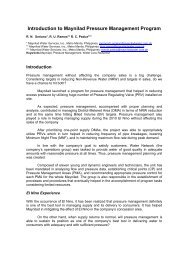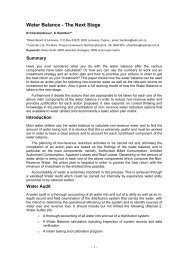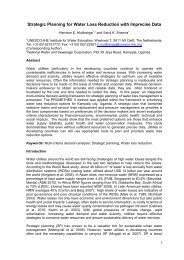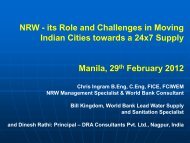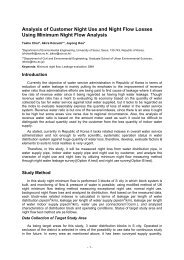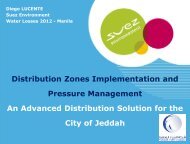The Challenge of Reducing Maynilad's Non ... - Iwa-waterloss.org
The Challenge of Reducing Maynilad's Non ... - Iwa-waterloss.org
The Challenge of Reducing Maynilad's Non ... - Iwa-waterloss.org
Create successful ePaper yourself
Turn your PDF publications into a flip-book with our unique Google optimized e-Paper software.
<strong>The</strong> <strong>Challenge</strong> <strong>of</strong> <strong>Reducing</strong> Maynilad’s <strong>Non</strong>-Revenue Water<br />
(Manila, Philippines)<br />
IRINEO L.DIMAANO<br />
Head,Central NRW Management<br />
Maynilad<br />
---------------------------------------------------------------------------------------------------------------------------<br />
1. INTRODUCTION<br />
<strong>Non</strong>-revenue water (NRW), poses a very big challenge to many water utilities today. <strong>Reducing</strong> if<br />
not totally eliminating non-revenue water remains the primary concern not only in the Philippines<br />
and the Asian region but also world-wide, especially in these times where sources <strong>of</strong> drinking<br />
water supply is rapidly declining.<br />
Better and more efficient water supply management is needed to optimize existing water<br />
resources by means <strong>of</strong> reducing the volume <strong>of</strong> water being lost through pipe leaks, meter underregistrations,<br />
illegal connections and other un-authorized withdrawal or use <strong>of</strong> water from the<br />
system.<br />
This paper intends to show how Maynilad, the private water operator <strong>of</strong> the West Zone <strong>of</strong> Metro<br />
Manila (Philippines), has faced its great NRW challenge: to reduce its huge volume <strong>of</strong> water<br />
losses equivalent to 1,500,000 m3/day in 2007, to improve level <strong>of</strong> service <strong>of</strong> its existing<br />
customers and to supply additional 2.5 million people still without access to piped water.<br />
Maynilad’s NRW management team, supported by Miya’s world class experts, has started to get<br />
physical and commercial losses in the system under control. <strong>The</strong> target is ambitious: the volume<br />
<strong>of</strong> NRW shall be reduced by 500,000 m3/day in less than four years.<br />
2. BACKGROUND OF MAYNILAD<br />
Metropolitan Waterworks and Sewerage System<br />
(MWSS) a government owned corporation providing<br />
water and sewerage services to the whole <strong>of</strong> Metro-<br />
Manila was privatized in 1997 and was divided into<br />
two (2) concession areas.<br />
<strong>The</strong> 1997 privatization was in response to the then<br />
pressing needs which were: 1) poor level <strong>of</strong> service, 2)<br />
high non-revenue water and, 3) the need to develop<br />
other water sources to meet the growing demand. A<br />
huge investment was required to answer these needs.<br />
<strong>The</strong> West Zone concession area which covers<br />
western portions <strong>of</strong> Metro- Manila (17 cities and municipalities) having 9 million plus<br />
population was awarded to Maynilad under the joint consortium <strong>of</strong> Benpres Holdings<br />
(Philippines) and Lyonnaise dex Eaux (France).
<strong>The</strong> East Zone concession area which covers the eastern portions <strong>of</strong> Metro-Manila ( 23 cities<br />
and municipalities) having 6 million population was given to Manila Water, a consortium <strong>of</strong> Ayala<br />
(Philippines),United Utilities (UK) Bechtel (USA) and Mitsubishi (Japan).<br />
<strong>The</strong> two concessionaires, who were each granted 25 years to manage each concession<br />
network, will act as agents and operators <strong>of</strong> MWSS responsible for operation and maintenance<br />
,service expansions and new investments.<br />
However, the impact brought about by the Asian financial crisis compounded by the effects <strong>of</strong> El<br />
Nino, led to the early termination <strong>of</strong> the concession contract in the West Zone.<br />
In 2004-2006, Maynilad was taken back by the government and placed under MWSS control<br />
and also prepared the way for its second privatization.<br />
In 2007,after a successful public bidding, the operation <strong>of</strong> Maynilad was awarded to the joint<br />
consortium <strong>of</strong> Metro Pacific Investment Corp. (MPCI) And D.M. Consunji Inc. (DMCI), two (2) <strong>of</strong><br />
the best Filipino owned companies in the Philippines<br />
In 2009, MWSS agreed to extend the concession agreement with both Maynilad and Manila<br />
Water by 15 more years to 2037 from 2022, the original expiry date.<br />
3. PROFILE OF MAYNILAD<br />
3.1. Service Area<br />
Maynilad covers an area <strong>of</strong> 540 square kilometers with approximately 9.3 million people. Raw<br />
water supply comes from Angat Dam in Bulacan, located north <strong>of</strong> Metro Manila, which provides<br />
96% <strong>of</strong> its total supply while the remaining 4% comes from Laguna Lake, located South east <strong>of</strong><br />
Metro-Manila and from few deepwells supplying the fringe areas in the south portions <strong>of</strong> the<br />
concession.<br />
It has three (3) water treatment plants with a total combined capacity <strong>of</strong> 2500 MLD : the La Mesa<br />
Treatment Plant-1 (1500 MLD),one <strong>of</strong> the biggest in Asia, and La Mesa Treatment Plant-2 (900<br />
MLD) which are both located in Novaliches,Quezon City, and the recently built Putatan Water<br />
Treatment Plant (100 MLD),located in Muntinlupa, which uses a micro-filtration and reverse<br />
osmosis system.<br />
Maynilad distribution network comprises <strong>of</strong> 5,575 kilometers <strong>of</strong> pipes <strong>of</strong> different materials,17<br />
pumping stations,18 reservoirs. Approximately,40% <strong>of</strong> its pipe network is more than 30 years<br />
old.<br />
It has 12 business area <strong>of</strong>fices that operate within specific boundaries catering to the needs <strong>of</strong><br />
over close to 1,000,000 customers; thus, making it the largest water utility in the Philippines.<br />
Its service coverage currently stands at 91% with the balance mostly comprising <strong>of</strong> the still unserved<br />
expansion areas in the South which are currently served by private groundwater wells.<br />
3.2. Customer Base<br />
Majority <strong>of</strong> Maynilad customers are domestic users (residential and semi-business<br />
establishments) which account for 94% <strong>of</strong> the total services while the non-domestic users<br />
(commercial and industrial establishments) account for the remaining 6%.
In terms <strong>of</strong> water billed volume, domestic users account for 79% <strong>of</strong> the total sales while nondomestic<br />
at 21%.Revenue wise, it is a close sharing <strong>of</strong> 57% and 43% respectively for domestic<br />
and non-domestic users.<br />
It is clearly evident that the non-domestics users, which are mostly situated in the Central Manila<br />
area and in the commercial and industrial zones <strong>of</strong> the concession, which provide almost half <strong>of</strong><br />
the total revenue must be given utmost attention. Currently, the top 1000 large accounts <strong>of</strong><br />
Maynilad are being given much priority in terms <strong>of</strong> water meter management and customer<br />
service.<br />
<strong>The</strong> remaining expansion or new areas in the South to be covered by Maynilad in the coming<br />
years are mostly made-up <strong>of</strong> domestic customers.<br />
Table 3.2.1: Maynilad Customer Base<br />
Customer Type Service Connections Annual Billed Volume Annual Revenue<br />
No. % MCM % MP %<br />
Domestic 849,461 94 2295 79 6,434 57<br />
<strong>Non</strong>-Domestic 54,221 6 79 21 4,854 43<br />
Total 903,682 100 374 100 11,288 100<br />
4. MAYNILAD’S NON-REVENUE WATER<br />
In the early 80’s, the MWSS under foreign assisted Manila Water Supply Rehabilitation Projects<br />
I and II (MWSRP-I and MWSRP-II) had implemented various NRW reduction programs. It<br />
applied the concept <strong>of</strong> zone/district metering which aimed to rehabilitate major portions <strong>of</strong> its<br />
distribution network to reduce high NRW and improve its level <strong>of</strong> service.<br />
Significant results were attained in the early stages <strong>of</strong> the program, thru massive replacements<br />
<strong>of</strong> old pipes, meters, appurtenances and others. However, improved level <strong>of</strong> NRW did not last<br />
long enough primarily due to the lack <strong>of</strong> supporting programs and right <strong>org</strong>anizations to monitor<br />
and sustain the improvements made.<br />
At the initial stage <strong>of</strong> Maynilad operation<br />
under private management, zone/sub-zone<br />
metering once again implemented in various<br />
parts <strong>of</strong> the system. Similarly, NRW target<br />
levels were achieved in areas where NRW<br />
reduction programs were carried out, but the<br />
eventual gains deteriorated after a period <strong>of</strong><br />
time due to lack <strong>of</strong> sustainable programs.<br />
Just after few years, this concept <strong>of</strong> NRW<br />
reduction was abandoned, and the program<br />
shifted to massive system wide leak repairs<br />
and meter replacements which eventually<br />
were not able to produce significant NRW<br />
reduction.
Other NRW related projects were also carried out by various groups in Maynilad, however, most<br />
<strong>of</strong> them were poorly managed and not well coordinated within the <strong>org</strong>anization. Evidently, there<br />
was no direct and full time ownership <strong>of</strong> the program. That is, many were involved but hardly a<br />
few were directly responsible. It was very evident that there was a lack <strong>of</strong> clear direction where<br />
the management wanted its NRW program to proceed.<br />
Ten (10) years after privatization, from 1997 until 2006, there were no significant changes in the<br />
system wide NRW level <strong>of</strong> Maynilad, except only in 1998 when it reached 61%. It was however,<br />
mainly caused by very low system input volume due to forced supply reduction brought about by<br />
the El Nino phenomenon.<br />
Under the MWSS take-over and operation in 2004-2006, no considerable accomplishment was<br />
made during the period in terms <strong>of</strong> reducing the level <strong>of</strong> NRW and improving the level <strong>of</strong> service.<br />
In 2007, when the MPIC-DMCI started its operation the NRW level was at 66% and recognized<br />
the magnitude <strong>of</strong> the problem and realized the golden opportunity in recovering this huge<br />
volume <strong>of</strong> water being lost in the system which was a staggering 1500 MLD. <strong>The</strong>y set an<br />
ambitious target <strong>of</strong> 40% NRW level at end <strong>of</strong> 2012.<br />
<strong>The</strong> new management team <strong>of</strong> Maynilad believed that to be viable, NRW level must be reduced<br />
significantly and operational efficiency must be improved.<br />
This basically involved significant investments on the following:<br />
<br />
<br />
<br />
<br />
<br />
NRW management program<br />
Rehabilitation <strong>of</strong> pump stations<br />
Re-commissioning <strong>of</strong> reservoirs<br />
Improvements in existing primary distribution lines<br />
Construction <strong>of</strong> new distribution facilities (Pumps, Boosters, and Primary lines)<br />
5. MAYNILAD’S CAPEX PROGRAM<br />
5.1. General Program<br />
<strong>The</strong> thrust <strong>of</strong> Maynilad’s CAPEX Program was to deliver the commitments in the Concession<br />
Agreement and address the concerns which prompted the privatization <strong>of</strong> its Operation; and<br />
these are to (a.) provide water to areas that were previously un-served (b.) improve the service<br />
level in the system and deliver uninterrupted water supply with sufficient pressure to customers<br />
(c.) and reduce the high volume <strong>of</strong> <strong>Non</strong>-Revenue Water.<br />
5.1.1. Long Term CAPEX Program<br />
Over the remaining 30 years <strong>of</strong> the Concession (2008-37), Maynilad commits to invest 3,962<br />
Million USD to improve water services to its customers. A significant component, almost 37% <strong>of</strong><br />
the total budget, <strong>of</strong> this investment is dedicated towards managing NRW in the system.<br />
<strong>The</strong> integration <strong>of</strong> NRW Management in the Investment Plan is needed to ensure the company’s<br />
viability. Without NRW Management, development <strong>of</strong> new water sources will need to be<br />
accelerated and larger distribution lines will be constructed as an allowance for the large water<br />
loss in the network.<br />
To avoid this situation, water loss in the system would have to be constantly managed and<br />
monitored. Unfortunately, NRW management requires substantial upfront investment, as such,
majority <strong>of</strong> investment equivalent to almost 69% will have to be spent in the first 15 years (2008-<br />
22) <strong>of</strong> the Operation. <strong>The</strong> remaining 31% is allocated in the next half <strong>of</strong> the concession term<br />
(2023-37).<br />
Table 5.5.1.1. Maynilad’s CAPEX Program (Total Concession Period)<br />
In Million USD<br />
Maynilad CAPEX Program<br />
2008-<br />
2012<br />
2013-<br />
2017<br />
2018-<br />
2022<br />
2023-<br />
2027<br />
2028-<br />
2032<br />
2033-<br />
2037<br />
Total CAPEX 941 1,075 1,078 727 724 506 5,051<br />
Water CAPEX 852 979 918 461 459 293 3,962<br />
Total<br />
NRW Management & 3R 496 393 209 136 126 103 1,465<br />
Operations Support 256 377 452 250 222 150 1,707<br />
Water Sources 99 208 256 74 111 40 790<br />
Wastewater CAPEX 87 91 156 262 262 209 1,068<br />
Sewerage 77 59 115 221 221 176 868<br />
Sanitation 10 33 41 42 41 33 200<br />
Natural Calamity Mitigation 2 4 4 4 3 3 21<br />
5.1.2. Short Term CAPEX Program<br />
Up to 2012, Maynilad plans on significantly improving service coverage with vast expansion<br />
plans to cover more areas in Cavite, Las Pinas and Muntinlupa in the South, and North<br />
Caloocan, Valenzuela and Commonwealth (QC) in the North. <strong>The</strong> plans are geared to increase<br />
coverage target and meet or exceed the 92% commitment.<br />
Parallel to increasing its service coverage, Maynilad will also improve the service levels in the<br />
areas that it is currently serving. From previous 56% <strong>of</strong> the customers receiving 24 hours water<br />
availability, the goal is to ensure that all served customers have continuous water supply by the<br />
end <strong>of</strong> 2012. Same plans will also apply to water pressure in the distribution.<br />
<strong>The</strong> investments related to this improvement will greatly improve reliability <strong>of</strong> water services in<br />
the West Concession.<br />
Service Obligation Targets<br />
Water,Sewerage & Sanitation Coverage<br />
Table 5.1.2.1. Maynilad’s Service Obligation Targets<br />
2008-2012 Targets<br />
2008 2009 2010 2011 2012<br />
Water 78% 81% 85% 90% 92%<br />
Sewerage 9% 8% 8% 11% 14%<br />
Sanitation 22% 31% 39% 45% 51%<br />
Water Availability & Pressure<br />
24-Hr Water Availability 56% 69% 83% 96% 100%<br />
Water Pressure-7 psi min 57% 64% 85% 95% 100%<br />
Water Service<br />
New Water Service Connections 44,321 52,491 69,549 88,125 31,825
Billed Services (Year End) 747,828 800,319 869,868 957,993 989,818<br />
6. NRW Management Program<br />
To meet the service obligation commitment <strong>of</strong> Maynilad, resources have to be optimized and<br />
properly allocated. NRW reduction and re-allocation <strong>of</strong> recovered water loss was a more viable<br />
option compared to the development <strong>of</strong> new and large water sources.<br />
6.1. Objectives<br />
<strong>The</strong> objectives <strong>of</strong> NRW Management Program are:<br />
<br />
<br />
<br />
Reduce physical losses by almost 500 MLD so that the anticipated demand can be<br />
met<br />
Reduce commercial losses to increase revenues<br />
Introduce a world class NRW management system so that the achieved reductions<br />
will be sustainable<br />
Prepare the ground for further NRW reduction after 2012<br />
<br />
In coordination with the business areas-to undertake social intervention and<br />
information on illegal connection, water service and water quality<br />
NRW Management Program is an integral component <strong>of</strong> the Maynilad CAPEX Program and was<br />
a necessary complement to the over-all strategy <strong>of</strong> the <strong>org</strong>anization. <strong>The</strong> program initially<br />
concentrated on the following key items to ensure its success:<br />
<br />
<br />
<br />
<br />
<br />
<br />
<br />
Hydraulic System Establishment<br />
District Metered Area (DMA)Establishment<br />
DMA Diagnostics and Leak Repair<br />
Selective Pipe Replacement<br />
Meter Management<br />
Instrumentation (Leak Detection and Data Logging)<br />
Capacity Building<br />
<strong>The</strong> implementation <strong>of</strong> above items was critical in laying the ground work for an effective NRW<br />
reduction and management. During the course <strong>of</strong> the program implementation, additional<br />
activities were added to the above list and these included; Pressure Management, Primary Audit<br />
and Leak Detection, Hydraulic Modeling and Calibration, and DMA Data automation and<br />
management.<br />
As <strong>of</strong> 2011, A total <strong>of</strong> 376 Million USD have already been spent on NRW Management<br />
Maynilad. Almost 86 Million USD more will be spent next year to further bring down the water<br />
losses.
6.2. NRW Targets<br />
<strong>The</strong> short and medium term goals <strong>of</strong> NRW Management in Maynilad is to deliver NRW reduction<br />
in the system by establishing scientific systems and implementing technically sound and<br />
pr<strong>of</strong>icient strategies. This entailed significant investment at the beginning <strong>of</strong> its operating years<br />
under the new management. <strong>The</strong> large up-front investments will also pave the way to enable the<br />
Company to easily manage its system in the future.<br />
Table 6.1.1 Maynilad’s NRW Targets<br />
NRW Targets 2007<br />
2012 2017 2022 2027 2032 2037<br />
(Actual)<br />
NRW in MLD 1,506 1,051 649 705 609 540 603<br />
NRW in Liters/<br />
Connection/Day (lcd)<br />
2,854 936 509 512 422 362 394<br />
NRW in % 66% 40% 30% 29% 24% 20% 20%<br />
<strong>The</strong> original approved term extension plan is currently in review, particularly the NRW reduction<br />
targets. It is expected that a more aggressive NRW target will be pursued by Maynilad over the<br />
next 15 years.<br />
6.2. NRW Assessment<br />
<strong>The</strong> system wide water balance in 2007 clearly shows that Maynilad NRW level is at 66% which<br />
is equivalent to a huge volume <strong>of</strong> 1500 MLD. About 75% <strong>of</strong> the total NRW is lost due to physical<br />
losses caused by deteriorated and poorly maintained pipes. Only about 25% <strong>of</strong> this volume is<br />
lost through commercial losses (meter inaccurracies, meter theft, illegal connections,etc).<br />
If half <strong>of</strong> this total NRW is recovered, it would be sufficient to provide adequate supply to the<br />
entire population in the concession area until 2015.<br />
Table 6.2.1. Maynilad 2007 Water Balance<br />
System Input<br />
Volume<br />
2,282 MLD<br />
(+/- 3 %)<br />
Authorized<br />
Consumption<br />
786 MLD<br />
Water Losses<br />
1,496 MLD<br />
(+/- 5 %)<br />
Billed<br />
Authorized<br />
Consumption<br />
785 MLD<br />
Unbilled<br />
Authorized<br />
Consumption<br />
1 MLD<br />
(+/- 22 %)<br />
Commercial<br />
Losses<br />
293 MLD<br />
(+/- 20 %)<br />
Billed Metered Consumption<br />
785 MLD<br />
Billed Un-metered Consumption<br />
0 MLD<br />
Unbilled Metered Consumption<br />
Marginal<br />
Unbilled Un-metered Consumption<br />
1 MLD (+/- 22 %)<br />
Unauthorised Consumption<br />
202 MLD (+/- 29 %)<br />
Customer Meter Inaccuracies and<br />
Data Handling Errors<br />
91 MLD (+/- 14 %)<br />
Revenue Water<br />
785 MLD<br />
<strong>Non</strong>-Revenue<br />
Water<br />
1,497 MLD<br />
(+/- 5 %)<br />
Physical Losses<br />
1,203 MLD (+/- 8 %)
A major aspect <strong>of</strong> Maynilad’s NRW Management Program is the prioritisation <strong>of</strong> activities. Due<br />
to the large pipe network <strong>of</strong> the system, there is a need to properly assess and focus on areas<br />
that will provide a big impact on NRW reduction <strong>of</strong> the entire Maynilad. This will also ensure that<br />
resources are properly utilized.<br />
For the Maynilad system, it is clear that the areas <strong>of</strong> highest leakage are the older parts <strong>of</strong> the<br />
system in the center <strong>of</strong> the concession area while the areas where the supply is poorest and<br />
serves only part <strong>of</strong> the population are the North and South <strong>of</strong> the system<br />
Analysis shows that 70% <strong>of</strong> the total volume <strong>of</strong> NRW which is 1000 MLD, is being lost in the<br />
Central Manila which has the oldest part <strong>of</strong> the distribution network. This is also where the<br />
commercial and industrial users are pre-dominant and where the huge concentrations <strong>of</strong><br />
schools, universities, malls, condominiums as well as the informal dwellers are present.<br />
<strong>The</strong> treatment plants are located in the North <strong>of</strong> the concession, while expansion and<br />
underserved areas are mainly located in the South. <strong>The</strong> North area includes high elevation area<br />
that reach 100 meters above sea level and is being supply through direct pump distribution from<br />
the treatment plant in La Mesa.<br />
Essentially, supply coming from the North will have to pass thru Central Manila to be able to<br />
expand coverage further South. It is therefore apparent that there is an immediate need to<br />
improve the network condition in the Central Manila tol ensure that adequate supply reaches the<br />
South.<br />
6.3. NRW Reduction Strategy<br />
A large distribution network like Maynilad, with poor pipeline conditions, can not be managed<br />
efficiently with out breaking them into smaller areas.<br />
Thus, the entire Maynilad network was divided into Hydraulic Systems/Zones (HS) and further<br />
down to smaller and more discrete District Metered Areas (DMA).<br />
Subdividing the network into HS and DMA enabled Maynilad to efficiently carry out<br />
measurements and diagnose the specific sources <strong>of</strong> NRW. Diagnostics is carried out on<br />
established DMA, concurrently with water audit <strong>of</strong> the primary lines. Ideally, these steps will be<br />
carried out succeedingly on DMA after it is ensured that the network is discrete:<br />
<br />
<br />
<br />
<br />
<br />
<br />
<br />
<br />
<br />
Baseline flow and pressure measurements<br />
Extraction <strong>of</strong> billed volume data (from meter reading/ billing system)<br />
Computation <strong>of</strong> NRW level (for prioritisation)<br />
Minimum night use reading (initial step prior to developing baseline data)<br />
Flow and pressure analysis<br />
Identify source <strong>of</strong> NRW ( Physical and/or Commercial)<br />
Address source <strong>of</strong> NRW<br />
Pressure management<br />
Others (Asset management, Monitoring <strong>of</strong> pressure on critical points, etc.)
<strong>The</strong> availability <strong>of</strong> DMA flow and pressure measurements also makes it possible to conduct<br />
efficient audit on primary mains. Water loss in DMAs typically represents NRW on the secondary<br />
and tertiary distribution systems, and when accounted for, will result to enabling the teams to<br />
discern the losses in the primary mains. Accounting for losses in the primary main lines will also<br />
facilitate the planning for an effective campaign for primary leak and illegal connection detection<br />
and resolution.<br />
6.4. Central NRW Team<br />
To make sure that whatever NRW gains achieved are sustained, a specific group has to take<br />
the lead and responsibility for the implementation <strong>of</strong> the entire NRW management program ,from<br />
conceptualization, execution to maintenance and sustenance.<br />
For this purpose, a dedicated Central NRW Team was created in 2008 giving them the full<br />
management support and leadership to lead the<br />
way in reducing Maynilad’s high NRW level.<br />
<strong>The</strong> NRW teams were placed across Maynilad’s<br />
business area <strong>of</strong>fices to manage day to day NRW<br />
operations and programs. To over-see and manage<br />
the whole program, there is the Central NRW core<br />
group that is based in the new <strong>of</strong>fice environment<br />
away from the old Maynilad headquarter. New and<br />
young engineers mostly coming top universities<br />
were hired.<br />
Apparently, still a gap existed then in the transition towards enabling the young Central NRW<br />
Team to efficiently undertake the NRW management program. This was the lack <strong>of</strong> actual<br />
experience, expertise and updated technology in NRW management. A technical partner was<br />
needed and the services <strong>of</strong> world class experts in various field <strong>of</strong> NRW management were<br />
required.<br />
6.5. Maynilad-Miya Partnership<br />
In the middle <strong>of</strong> 2008, Maynilad started looking into acquiring the services <strong>of</strong> a company that has<br />
proven experience and know-how on NRW management.<br />
In March 2009, Maynilad formally engaged the services <strong>of</strong> Miya, an Arison Group company who<br />
is a leading global provider <strong>of</strong> comprehensive<br />
solutions for urban water loss. Miya’s solution is<br />
based on best-practice methodology developed by<br />
International Water Association (IWA).<br />
Under the Technical Services Advisory (TSA)<br />
agreement between Maynilad and Miya, the latter will<br />
provide Maynilad’s Central NRW Team with technical<br />
advice, training and assistance to ensure the<br />
effective implementation <strong>of</strong> its NRW reduction<br />
program. Miya will also provide a system for<br />
improving data capture and analysis for water loss<br />
management <strong>of</strong> Maynilad.
7. SIGNIFICANT RESULTS<br />
7.1. Operational Highlights<br />
As <strong>of</strong> October 2011, the NRW level <strong>of</strong> Maynilad is at 45.2 %, historically the lowest level that it<br />
has achieved since it was privatized in 1997.It has reduced at an average rate <strong>of</strong> nearly 4% per<br />
year since 2007.<br />
<strong>The</strong> company’s billed volume is expected to grow by 40% at the end <strong>of</strong> 2011 to 405 million cubic<br />
meter (MCM) from 287 MCM in 2007.This continuous growth in billed volume reflects how<br />
Maynilad is steadily improving efficiency by reducing water losses coupled with improvement in<br />
the level <strong>of</strong> service. Service level has gone upward in terms <strong>of</strong> water availability and pressure.<br />
Table 7.1.1. NRW Volume Reduction<br />
Year 2007 2008 2009 2010 2011<br />
NRW Volume (MLD) 1507 1533 1448 1180 1035<br />
<strong>The</strong> total volume <strong>of</strong> water loss recovered from 2007 to end <strong>of</strong> 2011 as projected will be 472<br />
MLD. This was very instrumental in providing water supply to the additional 280,000 new<br />
services added to Maynilad customer base.<br />
Table 7.1.2. Service Coverage<br />
Year 2007 2008 2009 2010 2011<br />
Service Coverage(%) 77.0% 82.0% 85.6% 87.7% 91.3%<br />
Customers with 24-Hr<br />
Supply (%)<br />
Table 7.1.3. Water Availability<br />
Year 2007 2008 2009 2010 2011<br />
47 58 65 71 82<br />
Customers with 7-Psi<br />
Pressure(%)<br />
Table.7.1.4. Water Pressure<br />
Year 2007 2008 2009 2010 2011<br />
53 67 79 86 95<br />
Table 7.1.5. Billed Volume and Revenue<br />
Year 2007 2008 2009 2010 2011<br />
Billed Volume (MCM) 287 315 350 374 405<br />
Revenue (MP) 8,025 8,487 10,161 11,288 14,018
7.2. Establishment <strong>of</strong> HS and DMA<br />
As <strong>of</strong> October 2011,a total <strong>of</strong> 113 Hydraulic Systems and 798 District Metered Areas have been<br />
established, isolated and measured. <strong>The</strong> same has been established mostly in the priority areas<br />
where there is more potential for water loss reduction and recovery. <strong>The</strong>se were in Central<br />
Manila, Pasay and Paranaque.<br />
<strong>The</strong>re are already 247 Pressure Management Areas (PMAs) established coinciding with HS and<br />
DMA boundaries. <strong>The</strong>se PMAs contributed significantly on the leakage management activity and<br />
NRW reduction by controlling and or reducing the excess pressures and avoiding pressure<br />
fluctuations in the network.<br />
7.2.1. DMA NRW Data<br />
Average no. <strong>of</strong> connection per DMA is 858<br />
DMA coverage in terms <strong>of</strong> total Maynilad service connection is 70%<br />
56% <strong>of</strong> total Maynilad supply goes to these DMAs<br />
69% <strong>of</strong> the total Maynilad billed volume comes from DMAs<br />
Average NRW level <strong>of</strong> 798 DMAs is 32%<br />
7.3. Active Leakage Control<br />
7.3.1. Leak Detection and Repairs<br />
In 2009, Central NRW was assigned the full task <strong>of</strong><br />
undertaking all leak repair works on the pipe<br />
network-from primary distribution to secondary and<br />
tertiary distribution system,including service pipes<br />
and meter verticals and pipe appurtenances. This<br />
was totally upgrading the initially assigned task <strong>of</strong><br />
doing leak repairs on DMA only.<br />
Presently, Central NRW’s Leakage Detection<br />
Management unit has 22 leak detection teams<br />
(LDTs) fully equipped with modern leak detection<br />
equipment and well trained by top global leak<br />
detection experts.<br />
<strong>The</strong> LDTs are strategically assigned across Maynilad<br />
service area providing services to NRW Operations group and leak repair contractors.<br />
Various types <strong>of</strong> equipment have been tested and acquired and now being used by the LDTs in<br />
different field applications. Construction <strong>of</strong> Maynilad’s leak detection training center in Manila,<br />
which includes an actual field laboratory simulating different types and sizes <strong>of</strong> leaks is set to be<br />
operational by start <strong>of</strong> 2012.
With more than 100 repair teams available (outsourced to accredited contractors), Maynilad was<br />
able to increase its annual total number <strong>of</strong> repairs from 18,000 in 2009 to 40,000 repairs starting<br />
2010.<br />
In February 2010, the Leak Repair Control Center (LRCC) was established under Central NRW<br />
division to monitor and centralize leak repair operations. <strong>The</strong> tasks <strong>of</strong> the LRCC are to<br />
consolidate all leak complaints, monitors contractors accomplishments and to analyze how to<br />
further improve job order management, increase leak repair output and reduce leak repair<br />
runtime.<br />
7.3.2. Pipe Inspection <strong>of</strong> Large Diameter Pipes<br />
Before, the impression was Maynilad’s primary distribution system (PDS),large diameter pipes<br />
with 350 mm and above, have no losses, because there were no surfacing leaks and the<br />
capability and equipment to detect leaks were very limited and methods <strong>of</strong>ten used were<br />
obsolete.<br />
It was further aggravated by the existing conditions we have in Manila: noisy environment, and<br />
heavy traffic which compounded the background noise being captured by the conventional leak<br />
detection equipment. What was making it more difficult was the unreliable and not updated<br />
pipeline maps.<br />
In March 2010,Maynilad engaged Pressure Pipe Inspection Company,(PPIC) a Canada based<br />
company,for a Leak Location Services and Equipment Rental agreement, aimed to<br />
check,inspect,and locate leaks on Maynilad’s selected PDS using the Sahara System-a state<strong>of</strong>-<br />
the art leak detection technology that accurately detects leaks, pockets <strong>of</strong> trapped gas and<br />
structural defects in large diameter pipes.<br />
It was the first actual application <strong>of</strong> this technology in the Philippines and in this region. Prior to<br />
the start <strong>of</strong> the project, four Maynilad young engineers, were sent and trained in Canada. Follow<br />
through training was done here in Manila as part <strong>of</strong> the service provided by PPIC.<br />
<strong>The</strong> established DMAs on the SDS and TDS enabled Maynilad to measure water losses in the<br />
PDS. Maynilad has a total <strong>of</strong> 300 KM <strong>of</strong> PDS with size ranging from 300 mm DN to 3200 mm<br />
DN.Water audits <strong>of</strong> the identified segments were conducted and the volume <strong>of</strong> water loss was<br />
estimated to be substantial enough to supply<br />
adjacent expansion and underserved areas.<br />
Subsequently, Sahara inspection was carried out<br />
and findings reveal significant losses due to leaks,<br />
illegal connections, unknown laterals, not<br />
decommissioned old pipes and other network<br />
anomalies.<br />
To-date Maynilad is operating 2 units <strong>of</strong> Sahara,<br />
primarily in the high NRW areas <strong>of</strong> Central Manila<br />
and the operations are contributing significantly in<br />
the recovery <strong>of</strong> water being lost in the system. <strong>The</strong><br />
number <strong>of</strong> leaks repaired on the PDS in 2010 has<br />
significantly increased four times it was in 2009.
Table 7.3.2.1. Maynilad Sahara Operations Results<br />
Indicators 2010 2011 YTD Total<br />
Total KM pipe surveyed 115 113 228<br />
Leak locations detected 210 99 309<br />
Recovered volume (MLD) 73 34 106<br />
Average leak/KM 3.6 1 2.2<br />
Average distance surveyed<br />
M/day<br />
370 378 374<br />
Water Utility/Country<br />
Table 7.3.2.2. Comparative Results Sahara Operations<br />
Length <strong>of</strong> pipe surveyed<br />
per day (M)<br />
No.<strong>of</strong> leaks detected per<br />
KM<br />
Thames Water/UK 746 1.6<br />
WRC/Europe &North America 504 1.4<br />
EPAL/Portugal 781 1.3<br />
Lyden/Casablanca 688 0.7<br />
Maynilad/Philippines 374 2.2<br />
7.4. Integrated Meter Management<br />
Integrated Meter Management is the group under Central NRW that handles the over-all control<br />
and management <strong>of</strong> all tasks pertaining to water meters,from residential, commercial, industrial<br />
and DMA meters except for the flow meters being used to monitor the flow in key primary pipe<br />
gauging points which currently being handled by the Telemetry group.<br />
Before, several meter related tasks were done by various group in Maynilad resulting to<br />
uncoordinated and not properly programmed activities.<strong>The</strong>re was evidently lack <strong>of</strong> concerted<br />
efforts and the resources were scattered (data loggers, service vehicles, meters,etc).<br />
With the inclusion <strong>of</strong> the Integrated Meter Management (IMM) into the Central NRW Division,<br />
several improvements have already been effected, namely:<br />
<br />
<br />
<br />
<br />
<br />
Re-<strong>org</strong>anized the existing meter management unit and injected new and young<br />
engineers.<br />
Acquired the services <strong>of</strong> world class meter experts to guide the new meter<br />
management team.<br />
Re-evaluated performance <strong>of</strong> the different brands <strong>of</strong> meter and reduced the number<br />
to only five quality brands from the previous 23.<br />
Special attention is being given to large account customer meters, which is the<br />
source <strong>of</strong> almost half <strong>of</strong> Maynilad’s total revenue. Maynilad is shifting to a more<br />
advanced meter technology in this category to provide better service to the<br />
customers and to improve its monitoring and consumption analysis.<br />
Records show continuous increase in billed volume and revenue in the large<br />
customer meters top 1000 accounts.
Limited the re-use <strong>of</strong> refurbished meters which was done before in replacing large<br />
account meters resulting to lost<br />
revenues.<br />
Continuously conducting R&D on new<br />
meter technology and automated meter<br />
reading.<br />
Conducting trial installations <strong>of</strong> different<br />
types <strong>of</strong> meter and evaluate their<br />
applications.<br />
Re-built the old meter test facilities<br />
Moving forward, Maynilad starts to implement periodic meter replacement program aimed to<br />
systematically replaced the existing old type and less accurate meters. Different types <strong>of</strong> meters<br />
will be installed based on its application in a particular area.<br />
7.5. Capacity Building<br />
To sustain an effective NRW Management plan, Maynilad made significant investment in the<br />
development <strong>of</strong> its personnel. An NRW Management Training and Certification Program<br />
(NMTCP) was put up to be able to address the need for continuous skill assessment and<br />
upgrading for the personnel.<br />
<strong>The</strong> scope <strong>of</strong> the program is to evaluate the knowledge <strong>of</strong> personnel, provide training to bridge<br />
the gaps and ensure that they are kept up to date on the recent development in technology<br />
relevant to NRW management. Maynilad’s partnership with Miya was especially crucial in this<br />
Program because it allowed the Maynilad access to very knowledgeable specialists in the fields<br />
<strong>of</strong> NRW Management. As a result, these specialists, most <strong>of</strong> which are members <strong>of</strong> the IWA<br />
Water Loss Taskforce, were able to craft and conduct comprehensive training modules covering<br />
the fields <strong>of</strong>: NRW Assessment, Meter Management, Leak Detection, Pressure Management,<br />
PRV Maintenance, Hydraulic Modeling, GIS and Data Management, and DMA Operation and<br />
Management.<br />
Two new facilities, the Integrated Meter Management Building and the Leak Detection Training<br />
Center have also been constructed to ensure that the best possible venues are available to<br />
Maynilad personnel to learn and practice key NRW management activities.<br />
To date, Maynilad is already a recognized leader in the field <strong>of</strong> NRW Management because <strong>of</strong><br />
its significant achievements in the last four years. Part <strong>of</strong> the goal <strong>of</strong> this Organization is to also<br />
share its knowledge and expertise in the fields <strong>of</strong> NRW Management.<br />
7.6. Data Management System<br />
<strong>The</strong> availability <strong>of</strong> reliable information is critical in ensuring that decisions made by the<br />
management are sound and will yield the desired outcome. This also helps optimize resources,<br />
improve the confidence <strong>of</strong> decision and policy makers and expedite implementation <strong>of</strong> programs<br />
and target delivery. An important step that Maynilad took towards implementing a<br />
comprehensive NRW Management System is thru the use <strong>of</strong> Netbase.<br />
Netbase is a NRW Management System that allows data integration <strong>of</strong> different data sources.<br />
What could take weeks <strong>of</strong> running and generating reports for several hundred DMAs only takes
a few minutes with the help <strong>of</strong> this system. It accesses data sources from several Maynilad<br />
systems, namely:<br />
<br />
<br />
<br />
<br />
<br />
Billing System (SAP)<br />
Geographical Information System - GIS (Manifold)<br />
Customer Service Information System<br />
DMA flow and pressure data (Various System <strong>of</strong> Loggers)<br />
Work Order System (SAP-EAM)<br />
Due to the size <strong>of</strong> Maynilad’s system, it was apparent early on that a system to automatically<br />
produce relevant NRW report is needed. It allows daily monitoring and tracking <strong>of</strong> nightflows into<br />
the DMAs so the result from previous measurement can be readily made which greatly improves<br />
the reaction time and prioritization <strong>of</strong> personnel in determining the need to carry out leak<br />
detection.<br />
Maynilad’s GIS also play an important role in the future programs on NRW Management. <strong>The</strong><br />
availability <strong>of</strong> implemented leak repair works in this system will help the company prioritize and<br />
decide on future pipe rehabilitation projects. <strong>The</strong>se data will also allow for a more pro-active<br />
maintenance work and rehabilitation plans to be effectively carried out.<br />
8. PRESENT AND FUTURE CHALLENGES<br />
Maynilad might have hurdled most <strong>of</strong> the initial challenges it faced in its early years <strong>of</strong> NRW<br />
management but still it has suffered few setbacks. It needs to see the lessons learned in every<br />
setback and make them part <strong>of</strong> the team’s development.<br />
<strong>The</strong>se are the present and future challenges Maynilad is facing and will be facing to effectively<br />
implement and complete <strong>of</strong> its NRW program.<br />
<br />
<br />
<br />
<br />
<br />
<br />
<br />
Sustenance <strong>of</strong> improved level in NRW and level <strong>of</strong> service<br />
Quality data collection and management system<br />
Quality work implementation and supervision<br />
Working relationships with Local and National Government Units<br />
Working relationships with other Maynilad operations and support groups<br />
Capacity building and benchmarking with the best in the region<br />
Provision <strong>of</strong> right incentives to effect high level performance
9. CONCLUSIONS<br />
<br />
<br />
<br />
<br />
<br />
NRW reduction is a complex problem and not a simple program to implement<br />
Not only new technologies and international standards have to be adopted but right<br />
<strong>org</strong>anization and effective management must be established<br />
Management full support and leadership is very critical<br />
<strong>The</strong> need to invest in the capacity building and the provision <strong>of</strong> right incentive to the<br />
staff-which is the best asset <strong>of</strong> the company<br />
Maynilad is still far from its NRW targets, but it is now more confident than before;<br />
and it is only a matter <strong>of</strong> time - it will surely be one <strong>of</strong> the best water utilities in the<br />
region in the field <strong>of</strong> NRW management.







